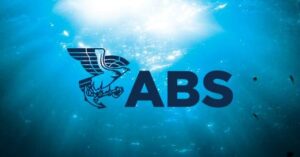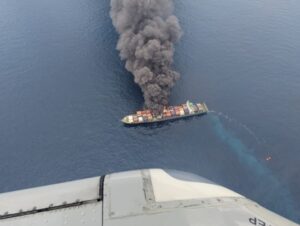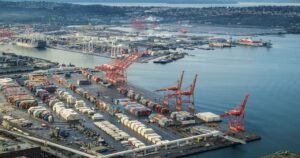Maersk Line has reported a 2016 result that is US$1,679 million lower than the 2015 result of $1,303 million, after a 19% decline in freight rates and revenue 13% lower than 2015 ($23.7bn) at $20.7 billi
It comes after A.P. Moller-Maersk A/S, owner of Maersk Line, surprised the market by posting its second annual loss since World War II and warned of the “very negative effect” of any trade war between China and the U.S.
The report highlights include Maersk Line’s average freight rate decreasing by 19% compared to 2015, volumes grew by 9.4%, and due to gradual improvements in container rates Maersk Line expects an improvement in excess of $1 billion in underlying profit compared to 2016.
Despite this, Maersk Line has stated that it has “a clear cost leadership” as part of A.P. Moller, Maersk’s Transport and Logistics division, which it views as an enabler for improving its product offering and customer experience through “innovative and digitalised solutions and services”.
But Maersk shares fell as much as 7.1% as the Copenhagen-based conglomerate reported a 2016 net loss of $1.94 billion.
According to Bloomberg, analysts had expected a $963 million profit.
Maersk’s chairman, Michael Pram Rasmussen, is also stepping down after almost 18 years on the board. He will be replaced by Jim Hagemann Snabe, who is also the chairman of Siemens.
Snabe, together with Soren Skou, who was promoted to Chief Executive Officer last year, will oversee Maersk’s plans to separate out its four energy units, which also include its North Sea petroleum producer, Maersk Oil, as the company focuses on its transport operations.
Skou recently stated that Q4, 2016 was the first time that demand has outgrown supply since 2010, and a significant increase in market share has meant volumes are 9.4% higher than in 2015 for Maersk Line.
This has been supported by its partnership with Mediterranean Shipping Line (MSC) through the 2M Alliance and will be enhanced by the move by Maersk Line in December 2016 to acquire Hamburg Süd.
The acquisition supports its growth strategy and ambitions in the North-South trades, which have seen a head haul increase of 7.3%, but is still subject to regulatory approvals and aims to be completed by the end of 2017.
Until then, Hamburg Süd and Maersk Line will continue business as usual.
The 10-year 2M Alliance agreement, which started in early 2015, most recently saw Maersk Line take on Hamburg Süd’s volumes on the East-West trades after the German carrier finalised a slot purchase agreement.
This move is backed by the report statistics that the largest increases in trade was from the East-West backhaul at 19% and comes as the price for shipping a 40-foot container from Hong Kong to Los Angeles has tripled from $776 to $2,336 at the end of January, according to Drewry, the London-based research firm.
Report: Bloomberg
This is the highest level for the route since 2013 and not far below the record in figures dating back to 2011.
However, Maersk Line will delay the delivery of nine 14,000 TEU vessels by one month and one year, with the last vessel delivered at the end 2018, which it predicts will have a positive effect on its cash flow.
The business has been impacted through APM Terminals (APMT), Maersk Group’s global terminal operating arm, too as it also reported a loss with a 33% drop in profit to $438 million for 2016. This was despite an extensive cost-cutting programme and increase in throughput at its global facilities.
However, APMT reported that it handled 37.3 million TEU last year, an increase of 3.7% on the previous year.
This is mainly due to the acquisition of the Spanish Grup Maritim TBC, which added 2 million TEUs in equity weighted volum,e and expanded APMT’s network to 73 terminals in 69 countries.
By the end of 2016, Maersk Line’s total capacity had grown 9.4% compared to the end of 2015. Maersk Line continues to manage capacity tightly resulting in high utilisation.
Pierre Danet, CFO of Maersk Line, said: “We made a loss in 2016 due to a 19% decline in freight rates. This loss is clearly unsatisfactory.
“On the positive side, we won market share, we continue to drive costs down and we increased our utilisation.
“We remain competitive. And we have a strategy that addresses the challenges in our industry.
“It will ensure that we continue to focus on customers, that we maintain our leadership position and that we again become profitable.”
In 2016, the container shipping demand growth was about 2-3% and the global container fleet (capacity) growth was about 4% compared to 2015.
Maersk Line expects global container shipping demand to increase by around 2-4% in 2017.
The gap between capacity entering and exiting the industry was the lowest in many years.
Compared to 2015, Maersk Line’s average freight rate declined with 19%. Despite some positive developments seen in the second half of 2016, freight rates remain depressed and unsustainable.
Danet added: “Overall, container shipping demand grew below our expectations. However, in the last half of 2016, we experienced better industry conditions than in the first half. First due to a better supply demand situation, which resulted in an improvement in freight rates.”
“There are encouraging signs; however the market situation is still very challenging. Rates and demand levels remain low. That is why we will continue to manage our capacity tightly.”
The strength of the 2M Alliance will be key for Maersk Line going forward, seen in the infographic below by Lloyd's List, however a new, larger rival is set to challenge 2M and create further challenges.
Ocean Alliance, set to sail in April 2017, will led by CMA-CGM and made up of China Cosco Shipping, Evergreen Line, and Orient Overseas Container Line. It will offer 40 services on the east-west trades with 498 port calls.










